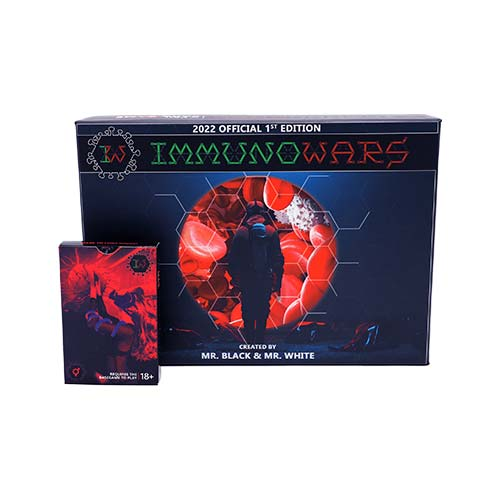Author: Anne Kuijper
Read time: 4 minutes
Scientists from the Trinity College Dublin recently discussed a new potential vaccination for whooping cough in a research paper. The vaccine is not administered via injection, but via inhalation through the nose. This vaccine protects both the airways and the inside of the nose. It not only prevents whooping cough infection but also inhibits asymptomatic transmission. This means that whooping cough would no longer be able to spread secretly from person to person.

Whooping cough vaccine
"With vaccinations, doctors want to ensure your body is prepared to deal with an infection," Dr. White explains. "Your immune system needs to be taught what the infection is, so it can adapt and create weaponry to eliminate it. Examples of these defensive weapons include molecules like serum immunoglobulins (Ig’s) and cells such as memory cells.
The current whooping cough vaccine is injected into your bloodstream (as most vaccinations are) and causes your body to make a type of immunoglobulin called IgG. IgG protects you against the worst of symptoms of whooping cough.
The effectiveness of the whooping cough vaccine wanes over time. Booster shots can be taken to improve immunity. However, if you have been vaccinated at least once in your life, your symptoms will be less severe than if you had never been vaccinated.
This is where the advantage of a nasal vaccination comes in. Instead of injecting the vaccine into the bloodstream, the vaccine can be breathed in through the nose. Experimental data suggests that the body reacts differently to the inhaled vaccine. More molecules and cells such as different types of immunoglobulins (IgA) and memory CD4 T-cells are made. The extra production of protective immune factors should prevent whooping cough from infecting the inside of the nose.
How does whooping cough spread
At the moment, whooping cough can spread secretly from person to person via the air, even when you are vaccinated. This is one of Mr. Blacks favorite tricks. In the first two weeks of the infection, you do not feel any symptoms yet. But you can infect others with whooping cough nevertheless.
Whooping cough makes itself at home in the upper airways. This location is not accidental. The upper airways are ideal for the disease to get from the body into the air. For example, when you sneeze or cough, small droplets are showered into the air which could make someone else sick.


In white, you can see the upper airways. The reddish color shows the lungs (image made by brgfx on Freepik).
What causes whooping cough
Whooping cough is caused by a bacterium called Bordetella Pertussis, also known as B. pertussis. When the bacteria settles in the upper airways, B. pertussis clings to your cilia. These are small hairs that make a sweeping motion that moves mucus up your airways back to your throat and mouth region. The cilia are important for cleaning your airways of gunk, debris, and potentially dangerous invaders of the body. When the mucus with potential invaders has been swept back to your throat and mouth area, you swallow everything. Then it will go to the stomach where everything is killed in the acid that is waiting there.
When B. pertussis attaches itself to the cilia, they produce toxins that suppress the sweeping movement of the cilia. This leads to swelling and inflammation in the upper airways, and together with the accumulation of thick mucus, causes the symptoms of whooping cough.
Can whooping cough kill you?
Generally, the infection is not too dangerous for the average healthy person. In contrast, babies younger than 1 year old are at high risk for complications and even death. Mr. White explains that sometimes babies cannot cough and instead struggle to breath or even stop breathing for a moment. People with a weak immune system can also become seriously ill from a whooping cough infection.
Typically, the average person may experience symptoms such as a clogged and runny nose, watery and red eyes, fever, and the characteristic cough. However, these symptoms are only present at the start of the infection. After a week or two, the cough worsens due to the accumulation of mucus in the upper airways. This can lead to extreme fatigue, a red or blue face from the intensity of coughing and lack of oxygen, or vomiting after an intense coughing fit.
Whooping cough for pregnant women and infants
The protective molecule IgG can pass from the mother's bloodstream to her child during pregnancy. The mother’s immune system has already produced these protective immunoglobulins, and by passing them on, she can protect her unborn child. Very young babies cannot be vaccinated, as their immune systems are not yet capable of preparing themselves for infections.
What does whooping cough sound like?
"It often sounds like a deep breath that sounds like ‘whoop’", explains Mr. White. The inhaling after the coughing, the whooping sound, can be more or less defined per person. So, confusingly, the cough doesn’t sound ‘whooping’ at all, the breathing in after does. So, if you are wondering if your cough may be something more, listen closely to yourself and remember to consult a doctor.
In the video below, Doctor Donovan shows some examples of what whooping cough can sound like, in both adults and children. "Be aware, the sounds might be disturbing to you", warns Mr. White.
Gameplay guide to B. Pertussis
B. pertussis is one of the infectious diseases that you can play in ImmunoWars. By using 3 ATP, you will force your opponent to role the die to either get -1 ATP for 5 turns or get an additional -3 HP on top as well.
It is a bacterium with a contagiousness and severity of two. Therefore, it is of mediocre difficulty to cure. To destroy B. pertussis, you can use the card called Abcetion, Antibiotics (ampicillin, ciprofloxacin, and penicillin), Bacteriophage, B-cell, CRISPR-Cas9, Macrophage, Monocyte or Natural Killer Cell. Each of these cards has different ATP costs, so make sure to stock up on ATP.
If you are desperate, close to death or very lucky, you can use the Bleach, Epinephrine, or Spontaneous Remission card, respectively.



